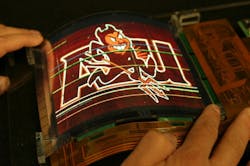World's largest flexible OLED display developed by ASU Flexible Display Center
Tempe, AZ--Using advanced mixed-oxide thin-film transistors (TFTs), the Flexible Display Center (http://flexdisplay.asu.edu) at Arizona State University successfully manufactured the world's largest flexible color organic light-emitting diode (OLED) display prototype. Measuring 7.4 diagonal inches, the device was developed at the Flexible Display Center in conjunction with Army Research Labs scientists and meets a critical target set by the U.S. Department of Defense to advance the development of full-color, full-motion video flexible OLED displays for use in thin, lightweight, bendable, and highly rugged devices.
"This is a significant manufacturing breakthrough for flexible display technology," said Nick Colaneri, director of the Flexible Display Center. "It provides a realistic path forward for the production of high performance, flexible, full color OLED displays, accelerating commercialization of the technology in the process."
ASU says mixed-oxide TFTs are a cost-effective approach for manufacturing displays with vibrant colors, high switching speeds for video, and reduced power consumption. Also, mixed-oxide TFTs can be manufactured on existing amorphous silicon production lines, eliminating the need for specialized equipment and processing, thereby reducing costs compared to competitive approaches.
"One of the primary directives of the Flexible Display Center has been to pursue approaches to flexible technologies that take advantage of existing manufacturing processes," continued Colaneri. "This focus drove us to pursue a flexible, color display based on mixed-oxide TFTs, which are widely regarded as a strong, cost-effective alternative to low-temperature polysilicon. This display showcases the Center's successful scale up to GEN II, and our ability to produce displays using mixed-oxide TFTs in standard process flows with our proprietary bond/de-bond technology."
The Flexible Display Center is a government/industry/academia partnership that is advancing full-color flexible display technology and fostering development of a manufacturing ecosystem to support the rapidly growing market for flexible electronic devices. The Flexible Display Center is unique among the U.S. Army's University centers, having been formed through a 10-year cooperative agreement with Arizona State University in 2004.
SOURCE: Arizona State University; https://asunews.asu.edu/20120531_flexdisplay_oled

Gail Overton | Senior Editor (2004-2020)
Gail has more than 30 years of engineering, marketing, product management, and editorial experience in the photonics and optical communications industry. Before joining the staff at Laser Focus World in 2004, she held many product management and product marketing roles in the fiber-optics industry, most notably at Hughes (El Segundo, CA), GTE Labs (Waltham, MA), Corning (Corning, NY), Photon Kinetics (Beaverton, OR), and Newport Corporation (Irvine, CA). During her marketing career, Gail published articles in WDM Solutions and Sensors magazine and traveled internationally to conduct product and sales training. Gail received her BS degree in physics, with an emphasis in optics, from San Diego State University in San Diego, CA in May 1986.
